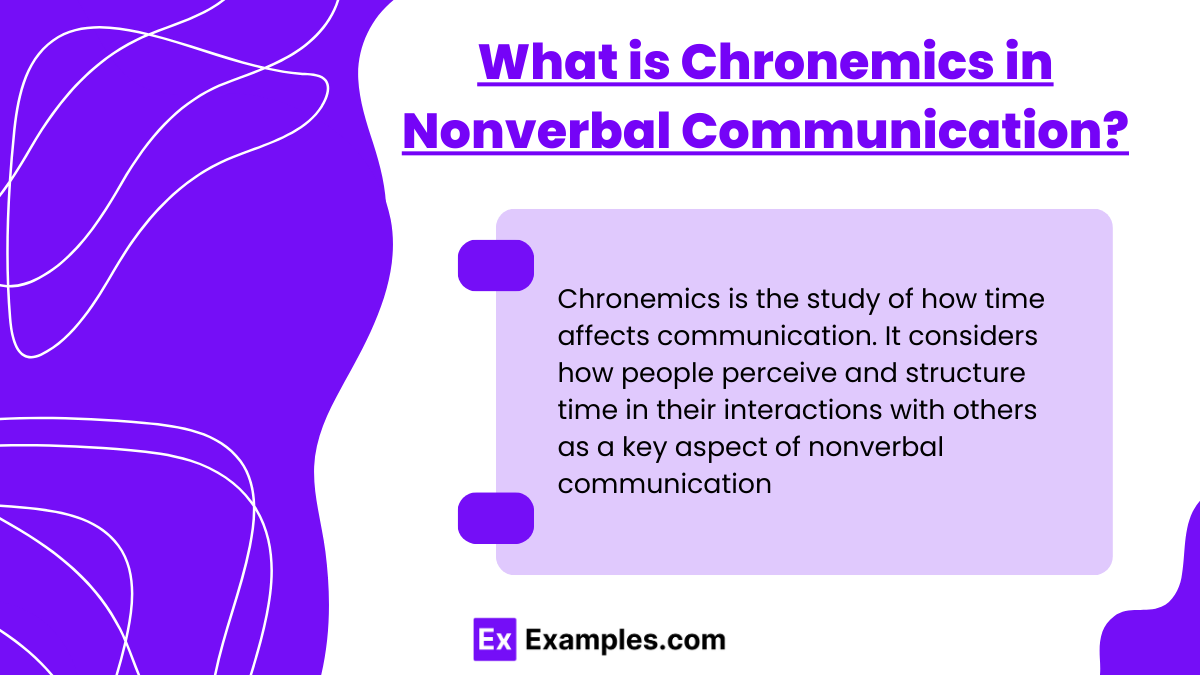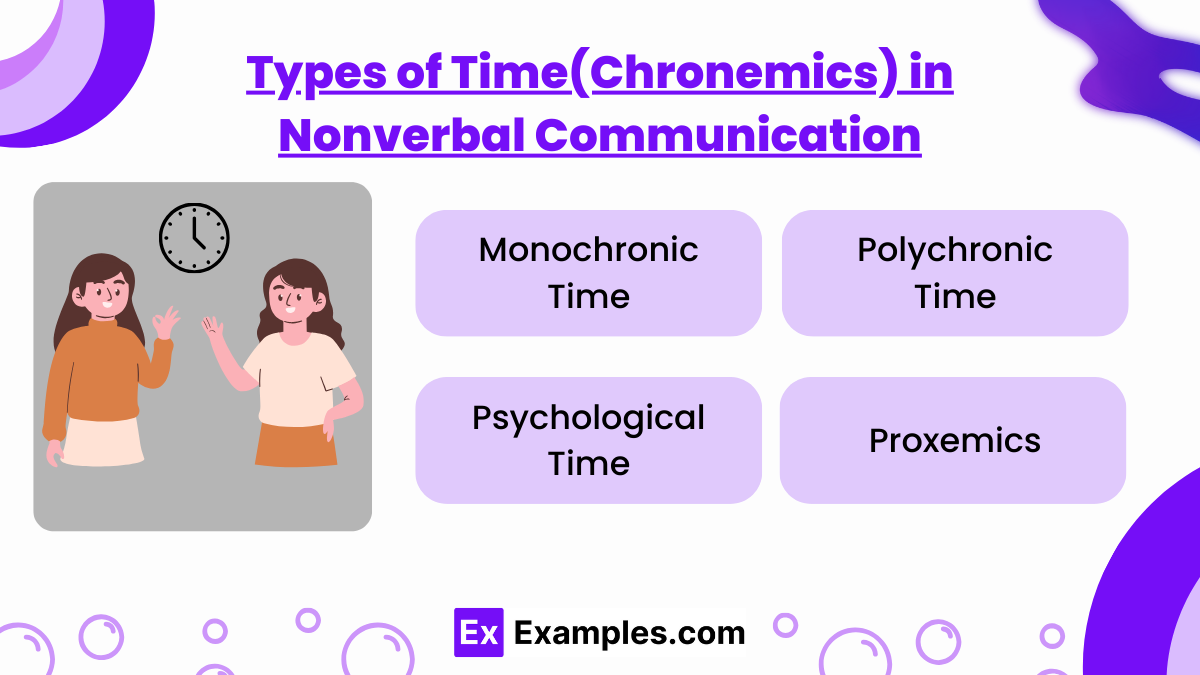29+ Time (Chronemics) in Nonverbal Communication Examples
Time plays a crucial role in how we communicate without words. Known as chronemics, this aspect of nonverbal communication reveals much about our attitudes, behaviors, and cultural backgrounds. Whether it’s how long we take to respond to messages, the punctuality we maintain for appointments, or how we manage time in conversations, each action communicates something significant about us to others. By exploring the concept of chronemics, we can better understand the subtle yet powerful messages conveyed through the use of time in our daily interactions.
What is Chronemics in Nonverbal Communication?

30 Examples of Chronemics in Nonverbal Communication
Understanding the role of time, or chronemics, in nonverbal communication is crucial. This article delves into 30 distinct characteristics of how time influences nonverbal interactions. From punctuality to the timing of gestures, these examples offer a comprehensive look at time in nonverbal communication, enriching our understanding of social dynamics.
- Punctuality in Meetings: Arriving on time shows respect and commitment. For instance, saying, “I ensure to be punctual to demonstrate my professionalism and respect for others’ time.”
- Pausing Before Responding: A thoughtful pause can indicate careful consideration. Example: “I pause briefly before answering to show I am contemplating your question seriously.”
- Rapid Responses in Conversations: Quick replies can signal eagerness or impatience. “I respond swiftly to show my enthusiasm for the topic.”
- Delayed Replies in Texting: Slow responses might suggest disinterest or busyness. “I might delay my text replies when I’m preoccupied, unintentionally signaling that I’m too busy.”
- Taking Time to Listen: Spending time listening shows attentiveness. “I devote time to listen carefully, indicating my genuine interest in the conversation.”
- Long Meetings vs Short Check-ins: The length of a meeting can convey its importance. “Our longer team meetings signify in-depth discussions, while short check-ins are for quick updates.”
- Frequency of Communication: Regular interactions can demonstrate priority and commitment. “I communicate frequently with my team to emphasize the project’s importance.”
- Timing of Nods During a Conversation: Nodding at appropriate times shows agreement and understanding. “I nod while listening to show I follow and agree with your points.”
- Extended Eye Contact: Prolonged eye contact can imply sincerity or intensity. “Maintaining longer eye contact, I express my seriousness about the subject.”
- Brief Glances: Short glances might indicate nervousness or distraction. “Quick glances around the room might show my nervousness in a social setting.”
- Duration of Handshakes: A long handshake can be seen as warm and inviting. “I give a slightly extended handshake to convey friendliness.”
- Speed of Walking in Entrances: Walking speed can reflect confidence or urgency. “I walk briskly into the meeting room to exhibit confidence.”
- Taking Time for Small Talk: Engaging in small talk shows interest in personal connections. “I spend a few minutes on casual conversation to build rapport.”
- Silences in Negotiations: Strategic silences can create pressure or allow for reflection. “I use silence as a tool to let the other party consider their stance.”
- Quick Gestures vs Slow Movements: The speed of gestures can convey different emotions. “Rapid hand movements might show my excitement, whereas slower gestures indicate calmness.”
- Regular Scheduling of Meetings: Consistent scheduling shows reliability and structure. “I schedule weekly meetings to maintain a consistent and reliable communication flow.”
- Time Spent on Greeting Others: The time dedicated to greetings can reflect warmth. “I take a moment to warmly greet each team member, showing my appreciation for their presence.”
- Timing of Smiles in Conversation: Smiling at the right moment can enhance connection. “I smile when discussing positive outcomes, reinforcing the good news.”
- Duration of Eye Contact in Different Cultures: Varying lengths of eye contact can signify cultural respect or misunderstanding. “I adapt my eye contact duration to respect different cultural norms.”
- Timing of Fidgeting: Fidgeting at crucial moments can indicate stress or impatience. “My fidgeting during a pause might show I’m anxious about the response.”
- Hesitation in Voice: Hesitation can suggest uncertainty or thoughtfulness. “When I hesitate in my speech, it might indicate I’m uncertain about my answer.”
- Rhythm of Speech in Presentations: The pace of speech can impact audience engagement. “I vary my speaking rhythm to keep the audience engaged and emphasize key points.”
- Timely Interruptions in Discussions: Interrupting at the right moment can show engagement or assertiveness. “I interrupt politely to offer a critical point, showing my active involvement.”
- Waiting Before Entering Personal Space: Respecting personal space and timing entry shows consideration. “I pause before entering someone’s personal space as a sign of respect.”
- Timing of Touch in Different Cultures: Understanding when to engage in physical contact is crucial for cultural sensitivity. “I’m mindful of when and how to use touch in various cultural contexts.”
- Length of Pauses During Speech: Strategic pauses can enhance communication effectiveness. “I use pauses in my speech to let key points sink in.”
- Frequency of Head Tilts in Listening: Frequent head tilts can indicate interest or empathy. “Tilting my head often during a conversation shows my engagement and empathy.”
- Timing of Laughter in Conversations: Laughter at appropriate moments builds rapport. “I laugh timely during conversations to create a friendly atmosphere.”
- Speed of Typing in Online Chats: Typing speed can signal urgency or consideration. “I type quickly in chats to show urgency, but slower for more thoughtful responses.”
- Time Allocated for Team Feedback: Allocating sufficient time for feedback shows value for team input. “I dedicate ample time for feedback, highlighting its importance in our process.”
Types of Time(Chronemics) in Nonverbal Communication

Monochronic Time
Monochronic time management is a style where individuals prefer to handle tasks one at a time, adhering strictly to schedules and viewing time as a limited resource. This approach emphasizes punctuality, detailed planning, and a structured lifestyle, often associated with business and professional settings.
Polychronic Time
Polychronic time management is characterized by multitasking and a flexible approach to scheduling. People who adopt this style prioritize relationships over the rigid adherence to time and are more adaptable to changes and interruptions, typical in many social and familial contexts.
Psychological Time
Psychological time refers to how individuals perceive and experience time internally. This perception significantly influences one’s behavior in communication, such as how quickly one responds to others or feels pressure as deadlines approach. It highlights the subjective nature of time and its impact on interactions.
Proxemics
Though not directly a type of chronemics, proxemics relates closely as it involves the use of time in spatial arrangements. This type examines how physical distance between people affects communication and can reflect the temporal aspects of interaction, like the timing and duration of face-to-face encounters.
Importance of Time Chronemics in Nonverbal Communication

Time Chronemics plays a pivotal role in nonverbal communication, profoundly influencing interpersonal interactions and perceptions. Chronemics, the study of time’s role in communication, extends beyond mere timekeeping. It encompasses how time affects communication in different contexts, including punctuality, the amount of time spent in interactions, and the timing of responses.
- Cultural Interpretation: Different cultures interpret time differently. In some cultures, punctuality is a sign of respect, while in others, a more relaxed approach to time is common.
- Perception of Professionalism: In professional settings, adherence to time schedules often conveys reliability and competence.
- Relationship Dynamics: The time one dedicates to others can indicate the value placed on that relationship. More time spent can imply deeper engagement or interest.
- Communication Efficacy: Effective use of time in communication can enhance message clarity and impact.
- Psychological Impact: Time management in communication can affect stress levels and emotional responses. Delays or haste in responses can trigger different emotional reactions.
In summary, Time (Chronemics) in Nonverbal Communication is essential for conveying respect, professionalism, and emotional intelligence. Understanding and appropriately adapting to the time norms of different cultures and contexts is crucial in effective communication.
Role of Time Chronemics in Nonverbal Communication
The role of time in nonverbal communication, or chronemics, is multifaceted, influencing how messages are perceived and understood:
- Regulating Conversations: Time plays a crucial role in regulating the flow of conversations. Pauses and silences can convey thoughtfulness, discomfort, or disinterest.
- Signaling Status and Power: Individuals in higher positions often control the timing and duration of interactions, highlighting power dynamics.
- Influencing Decision-Making: The time taken to respond can affect decision-making processes, with quick responses signaling confidence or impulsiveness, and delayed responses indicating caution or uncertainty.
- Shaping Perceptions: Consistent punctuality or chronic tardiness can shape others’ perceptions of reliability and professionalism.
- Cross-Cultural Communication: Understanding different cultural time orientations is crucial in global communication, helping avoid misunderstandings and fostering mutual respect.
In essence, Time (Chronemics) in Nonverbal Communication plays a significant role in conveying unspoken messages and shaping interpersonal dynamics. Mastery of time use in communication is a key component of effective nonverbal communication, essential in both personal and professional contexts.
In conclusion, understanding the multifaceted role of time (Chronemics) in nonverbal communication enhances not only our personal interactions but also our professional relationships. The subtle nuances of time usage in communication, whether it’s in responding promptly, respecting others’ time, or managing time effectively during presentations, significantly impacts how we are perceived and how well we connect with others.
In the professional realm, this awareness becomes even more crucial. As highlighted by Harvard’s Professional Development blog, nonverbal cues, including time management and punctuality, can significantly influence communication outcomes. Their article on improving communication skills provides valuable insights into the intricacies of nonverbal communication, including the impact of time. Additionally, Stanford Graduate School of Business emphasizes the importance of building strong, respectful relationships, both personal and professional. Their resources on effective communication stress the need for understanding and adapting to different time perceptions and preferences in various cultural and professional contexts.
For further reading on these topics, consider exploring these resources:
- Harvard Professional Development’s blog on Improving Communication Skills, which delves into the complexities of nonverbal communication, including time management.
- Stanford Graduate School of Business’s insights on Building Successful Relationships, focusing on effective communication in both professional and personal life, with an emphasis on understanding and respecting time in various contexts.
FAQs
How does monochronic time affect communication?
Monochronic time encourages punctuality, scheduling, and a structured approach, affecting how time-sensitive communications are handled.
What is polychronic time in nonverbal communication?
Polychronic time involves managing multiple tasks simultaneously and valuing relationships over strict scheduling in communication contexts.
Can chronemics vary between cultures?
Yes, perceptions of time and its management in communication vary significantly across cultures, influencing punctuality, scheduling, and response expectations.
How does psychological time impact communication?
Psychological time shapes how individuals experience and react to time internally, affecting their promptness, responsiveness, and interaction timing.
What role does proxemics play in chronemics?
Proxemics, while focused on space, intersects with chronemics by influencing the timing and duration of interactions in physical settings.



